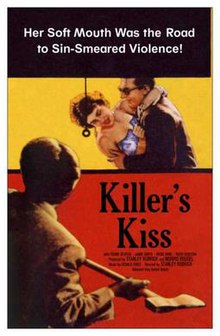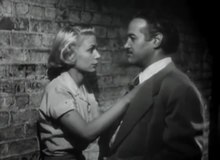Killer's Kiss
| Killer's Kiss | |
|---|---|
 Theatrical release poster | |
| Directed by | Stanley Kubrick |
| Screenplay by | Howard Sackler (uncredited) |
| Story by | Stanley Kubrick |
| Produced by |
|
| Starring |
|
| Cinematography | Stanley Kubrick |
| Edited by | Stanley Kubrick |
| Music by | Gerald Fried |
Production company | Minotaur Productions |
| Distributed by | United Artists |
Release dates |
|
Running time | 67 minutes |
| Country | United States |
| Language | English |
| Budget | $75,000[1] |
Killer's Kiss is a 1955 American crime film noir directed by Stanley Kubrick and written by Kubrick and Howard Sackler. It is the second feature film directed by Kubrick, following his 1953 debut feature Fear and Desire. The film stars Jamie Smith, Irene Kane, and Frank Silvera.[2]
The film is about Davey Gordon (Jamie Smith), a 29-year-old welterweight New York boxer at the end of his career, and his relationship with his neighbor, taxi dancer Gloria Price (Irene Kane), and her violent employer Vincent Rapallo (Frank Silvera).
Plot[]
Davey Gordon is a middleweight boxer near the end of the line. He's set to fight a top upcoming talent, with the winner in line for a title shot, but that's not going to be Gordon. He sits alone in his meager apartment, one step up from a flop-house, brooding away the time till he meets Kid Rodriguez. Across the courtyard, Gloria, an attractive but world-weary taxi dancer, is getting ready for work. Each steals stealthy glances at the other, but their eyes never meet. Walking out of the building, they run into each other but say nothing. Gloria is picked up by her boss Vincent.
As Davey is being dropped by one knockdown after another, Gloria is fending off her boss Vincent's persistent pawing. That evening, after losing the fight and deep in a disturbing dream, Davey is awakened by a scream coming from Gloria's apartment. He rushes to the window and sees that Gloria is being attacked by Vincent. Before he can scamper across the rooftop to her room Vincent hears him coming and makes his getaway. Davey comforts Gloria and offers to stay with her as she drifts off to sleep, silently but curiously inspecting her keepsakes and hanging lingerie before leaving.
The couple reunites for breakfast at Gloria's, where they share their life stories. With nothing holding either to New York they decided to go together to Davey's Aunt and Uncle's ranch near Seattle, a caring pair who appear to be his only surviving kin who have repeatedly invited him to return.
While Gloria is up at the dance hall quitting and seeking her last week's pay, Davey has a rendezvous planned with his manager to collect his share of the fight's purse. When Vincent hears she is leaving, he balks and tries to wheedle her plans from her. She stonewalls him and is told to get out. Waiting for Davey she stands outside the entrance next to a man she doesn't know. Still furious over the previous night and taking Gloria away from him, Vincent sends two goons out to rough Davey up, but they mistake the man near her for him. Chasing him into an alley they go too far and kill his manager instead.
Vincent kidnaps Gloria and he and his two goons hold her in a run- down hideout in a brick wasteland. Davey returns to Gloria's apartment and sees police searching his room. They assume he robbed and killed his manager. Davey leaves to rescue Gloria, but he is captured and restrained as well, leading to a chase and confrontation in an abandoned warehouse full of mannequins. During the struggle, Davey kills Vincent, then returns with the police to free Gloria. Davey is cleared of all charges, and buys a train ticket back to the West Coast. At the train station, Davey assumes she will not join him, but at the last minute, Gloria rushes in, and they kiss.
Cast[]
- Jamie Smith as Davey Gordon
- Irene Kane as Gloria Price
- Frank Silvera as Vincent Rapallo
- Jerry Jarrett as Albert (the fight manager)
- Mike Dana as Gangster
- Felice Orlandi as Gangster
- Skippy Adelman as Mannequin factory owner
- David Vaughan as Conventioneer
- Alec Rubin as Conventioneer
- Ralph Roberts as Gangster
- Phil Stevenson as Gangster
- Ruth Sobotka as Iris/ballerina
Background[]
This was Kubrick's second feature. Kubrick removed his first film Fear and Desire from circulation over his dissatisfaction with it. Kubrick directed it between the ages of 26 and 27, and had to borrow $40,000 from his uncle Martin Perveler, who owned a chain of drug stores in Los Angeles.[3]: 78 Killer's Kiss, originally titled Kiss Me, Kill Me,[4] was also financed privately through family and friends, but because Fear and Desire did not recoup its production budget, Perveler did not invest this time. Most of the initial budget was covered by Morris Bousel, a Bronx pharmacist who was rewarded with a co-producer credit.[3]: 95
Kubrick began to shoot the film with sound recorded on location, as was common practice in Hollywood. However, frustrated by the intrusion of the microphone into his lighting scheme, Kubrick fired his sound-man and decided to post-dub the entire film as he had with his first film.[5] The film is notable for its location shots in the old Penn Station, which was demolished in 1963, as well as Times Square, and the run-down streets of the Brooklyn waterfront and Soho loft areas.
Ballerina Ruth Sobotka, Kubrick's wife at the time, was the art director for this film, as well as for Kubrick's next, The Killing. She is also featured in a long dance solo, playing the role of Iris. Irene Kane (real life writer Chris Chase, née Irene Greengard) is the female lead.
Against Kubrick's wishes, United Artists required the film be recut with a happy ending.[6] United Artists paid $100,000 for the film and also agreed to provide $100,000 for Kubrick's next, The Killing.[7]
The film features a song "Once", written by Norman Gimbel and Arden Clar.[8] It is one of Gimbel's earliest contributions to a film, although his lyrics do not actually appear in the final version.[8]
Kane later reverted to her real name, Chris Chase, and became a respected author and print and television journalist, including a six-year stint on CNN.
Reception[]
Critical response[]
When released, the staff at Variety magazine gave the film a mixed review, and wrote, "Ex-Look photographer Stanley Kubrick turned out Killer's Kiss on the proverbial shoestring. Kiss was more than a warm-up for Kubrick's talents, for not only did he co-produce but he directed, photographed and edited the venture from his own screenplay [originally written by Howard Sackler] and original story...Kubrick's low-key lensing occasionally catches the flavor of the seamy side of Gotham life. His scenes of tawdry Broadway, gloomy tenements and grotesque brick-and-stone structures that make up Manhattan's downtown eastside loft district help offset the script's deficiencies."[9]
More recently, New York Times film critic Janet Maslin reviewed the film, and wrote, "Killer's Kiss brought the director onto more conventional territory, with a film noir plot about a boxer, a gangster and a dance hall girl. Using Times Square and even the subway as his backdrop, Mr. Kubrick worked in an uncharacteristically naturalistic style despite the genre material, with mixed but still fascinating results. The actress playing the dance hall girl, billed as Irene Kane, is the writer Chris Chase, whose work has frequently appeared in The New York Times. Jamie Smith plays the boxer, whose career is described as 'one long promise without fulfillment.' In the case of Mr. Kubrick's own career, the fulfillment came later. But here is the promise."[10]
Rotten Tomatoes rates it 84% "Fresh," based on eighteen reviews.
Awards[]
Wins
- Locarno International Film Festival: Prize, Best Director, Stanley Kubrick; 1959.[11]
Adaptation[]
In 1983 Matthew Chapman directed Strangers Kiss, a film that portrayed the making of Killer's Kiss.
Home media[]
The film was released on DVD and Blu-ray as a special feature of The Criterion Collection's release of Kubrick's The Killing.[12] A 4K UHD release was announced on January 2, 2022 by Kino Lorber.
See also[]
References[]
- ^ Stafford, Jeff. "Killer's Kiss (1955) - Articles". Turner Classic Movies. Retrieved December 4, 2014.
- ^ Killer's Kiss at IMDb.
- ^ a b LoBrutto, Vincent (1999). Stanley Kubrick: A Biography. New York: Da Capo Press. ISBN 0-306-80906-0.
- ^ Castle, Alison; Kubrick, Stanley (2005). The Stanley Kubrick Archives. Taschen Deutschland GmbH. p. 76. ISBN 978-3-8228-2284-5.
- ^ Hughes, David (2000). The Complete Kubrick. Virgin Publishing Ltd, pp. 26-27.
- ^ Merritt, Greg (2000). Celluloid Mavericks: The History of American Independent Film. Basic Books. p. 139. ISBN 9781560252320.
- ^ Tino Balio, United Artists: The Company That Changed the Film Industry, University of Wisconsin Press, 1987 p. 157
- ^ a b Gengaro, Christine Lee (2012). Listening to Stanley Kubrick: The Music in His Films. Rowman & Littlefield. pp. 15, 18. ISBN 9780810885646.
- ^ Variety film review (1955); last accessed February 21, 2008.
- ^ Maslin, Janet. Ibid.
- ^ "Winners of the Golden Leopard". Locarno. Archived from the original on 2009-07-19. Retrieved 2012-08-12.
- ^ "The Killing". The Criterion Collection.
External links[]
- Killer's Kiss at IMDb
- Killer's Kiss at Rotten Tomatoes
- Killer's Kiss at AllMovie
- Killer's Kiss at the TCM Movie Database
- Killer's Kiss informational site and DVD review at DVD Beaver (includes images)
- 1955 films
- English-language films
- 1955 drama films
- American films
- American black-and-white films
- American boxing films
- 1950s English-language films
- Film noir
- Films directed by Stanley Kubrick
- Golden Leopard winners
- Mannequins in films
- Films with screenplays by Stanley Kubrick
- United Artists films
- Films produced by Stanley Kubrick
- Films scored by Gerald Fried
